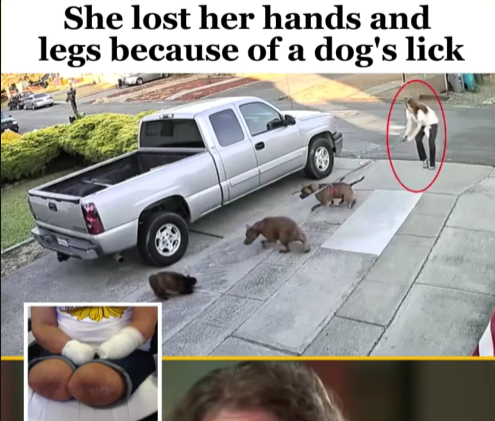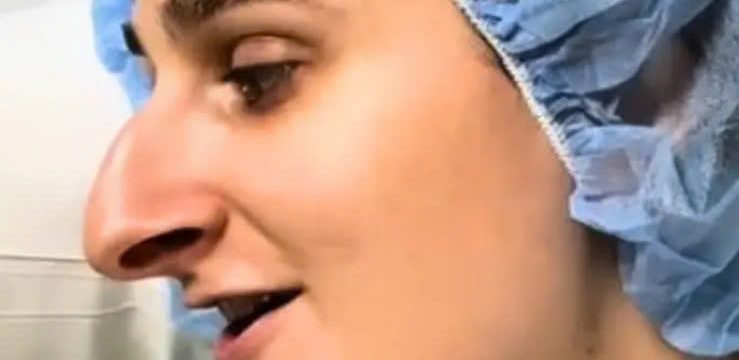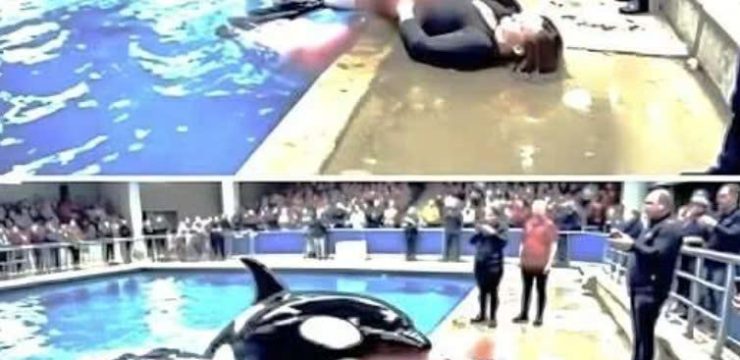It all began with what seemed like a sweet, harmless moment—a playful lick from a friendly dog. For millions of pet owners, this is a simple gesture of affection, a reminder of the deep bond between humans and their four-legged companions. But for one woman, that single act would set off a devastating chain of events that no one could have predicted. Within days, what began as a casual encounter spiraled into a fight for her life, ending with the loss of both her hands and legs.

It was an ordinary day, the kind that blends easily into memory—bright sunlight, a light breeze, and laughter echoing in the distance. She had spent part of the afternoon outside, where she met a dog that seemed gentle and well-behaved. When the dog licked her hand, she didn’t think twice. After all, most people wouldn’t. But as the days passed, something began to feel wrong. It started with fatigue, body aches, nausea, and chills—symptoms she assumed were from a simple flu. A quick rest, she thought, and it would pass. Yet behind those familiar signs, an invisible danger was quietly taking hold of her body.
Unbeknownst to her, the dog’s saliva contained Capnocytophaga canimorsus—a rare bacterium found in the mouths of many dogs and cats. For animals, it’s harmless. For humans, it almost always poses no risk. But in incredibly rare cases, when the bacteria enter the bloodstream through even a tiny cut or abrasion, it can lead to an overwhelming infection and a life-threatening condition called sepsis. For this woman, that rare exception became her grim reality.
Her health began deteriorating rapidly. Within a few short days, her mild fever turned into unbearable pain and confusion. She was rushed to the hospital, where doctors quickly realized she was in septic shock. Her blood pressure plummeted. Her organs were under severe distress. Clots began forming throughout her circulatory system, cutting off blood flow to her extremities. It was a race against time.
Medical teams worked relentlessly, administering antibiotics, fluids, and oxygen, but her condition continued to worsen. Doctors soon faced an agonizing decision—one that would change her life forever. To save her, they had to amputate both her hands and legs. “We didn’t have the luxury of waiting,” one physician explained. “Her body was shutting down. It was life or limbs.”
The surgery saved her life, but the emotional toll was unimaginable. The woman woke up to a reality she never could have prepared for. The same friendly gesture—a dog’s lick—that had once made her smile had now left her permanently changed. Her story spread rapidly online, shocking the public and sparking countless conversations about pet safety, rare infections, and medical awareness.
Yet even amid the flood of sympathy and fear, doctors stressed an important point: such infections are extraordinarily rare. Millions of people interact with dogs and cats daily without ever experiencing harm. Most cases of Capnocytophaga infections occur in individuals with weakened immune systems, chronic conditions, or open wounds. Basic precautions—washing hands after pet contact, avoiding letting animals lick broken skin, and monitoring any unusual symptoms—are generally enough to prevent serious illness.
Still, her case serves as a stark reminder that rare doesn’t mean impossible.
As she began her recovery, her resilience stunned everyone around her. Fitted with prosthetic limbs, she embarked on months of grueling physical therapy. Each movement, each new step, was a small victory. Her family, friends, and an entire online community rallied behind her, sharing messages of support and admiration. Through her determination, she became a symbol of courage—a living reminder that even after unimaginable loss, it’s possible to rebuild a meaningful life.
Instead of retreating into silence, she chose to speak out. She began sharing her experience publicly, hoping to raise awareness about early infection symptoms and the importance of seeking prompt medical care after animal contact. “If my story can help even one person recognize the signs sooner, then it’s worth it,” she said in an interview. Her openness turned tragedy into purpose, offering both education and inspiration.
Medical professionals have since used her story to emphasize key lessons. Any wound, even a small scratch or bite from a pet, should be cleaned immediately and monitored. If fever, fatigue, or flu-like symptoms develop unexpectedly after exposure to an animal, it’s essential to seek medical attention. Sepsis can progress within hours, and early intervention often determines whether a patient survives without severe complications.
For this woman, survival came at an extraordinary cost—but her outlook remains remarkably strong. She often speaks about gratitude: gratitude for the doctors who fought to save her, for the technology that allows her mobility, and for the second chance at life she almost didn’t have. Her courage reminds others that even in the darkest moments, human spirit and resilience can shine through.
Her story also reshaped how many people view their relationships with pets. Dogs and cats bring immense joy and comfort, but as with anything in life, awareness and balance matter. Experts encourage responsible pet ownership, regular veterinary care, and mindful hygiene—steps that protect both animals and humans.
As she continues her journey, she refuses to be defined by what happened. Her social media accounts now serve as platforms for hope and education. She posts updates about her progress, shares photos of her therapy milestones, and connects with others facing limb loss or severe illness. Her message remains simple but powerful: “Life can change in a moment, but it can still be beautiful.”
Her strength has touched thousands who once only knew her as “the woman in the headline.” Now, they see her as something far greater—a survivor, an advocate, and a reminder that compassion and knowledge can coexist even in tragedy.
In the end, her experience is both heartbreaking and enlightening. It underscores the fragile line between ordinary moments and life-altering ones. While most pet interactions bring love and laughter, her story urges us to stay aware and proactive about our health. What began as a playful gesture from a dog became an unimaginable ordeal, but through resilience, hope, and education, she turned pain into purpose. Her courage stands as a testament to the power of survival—and to the truth that even when life changes in the blink of an eye, the human heart can still find ways to heal and inspire.





